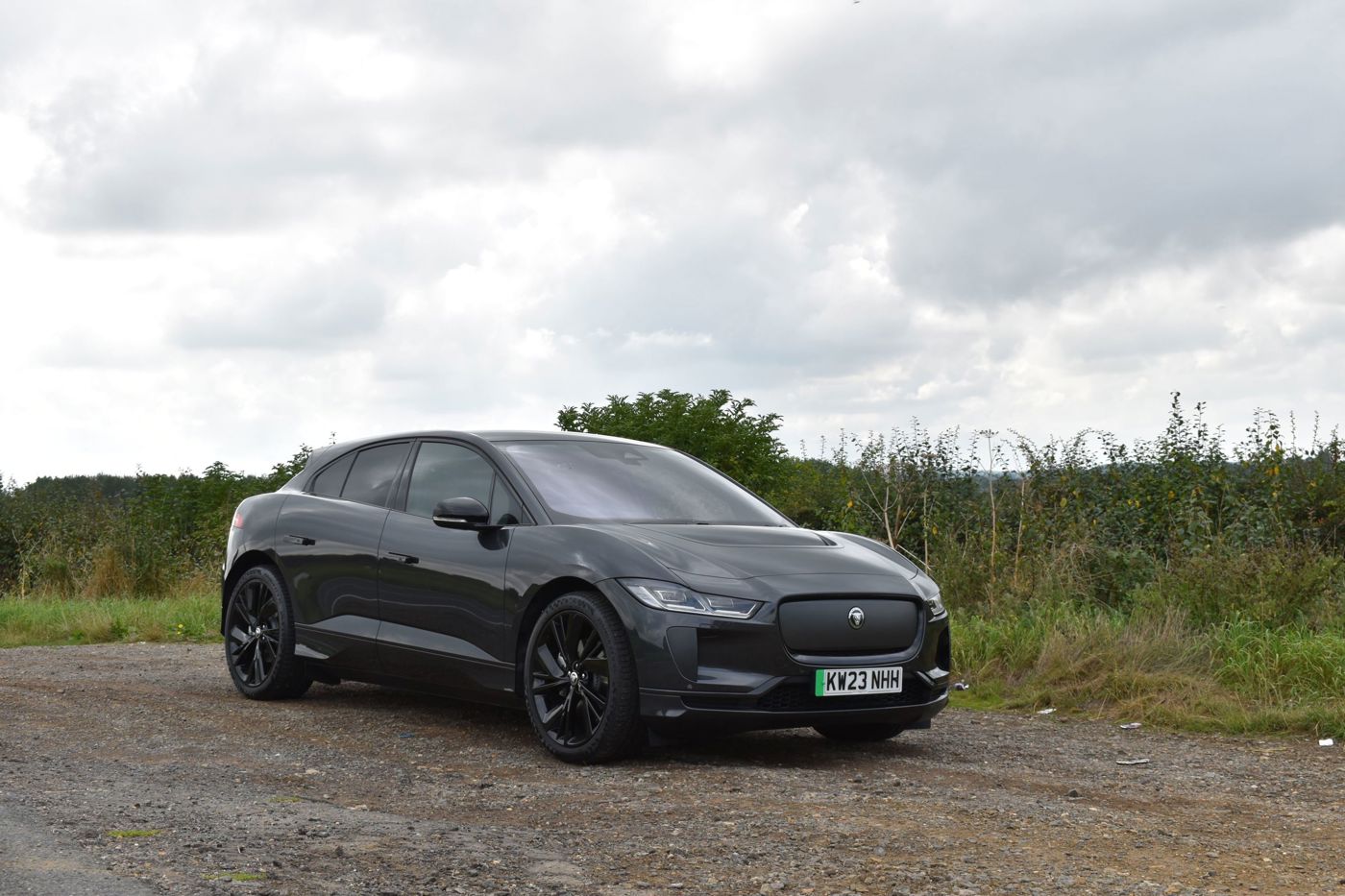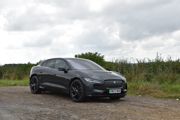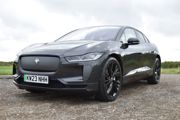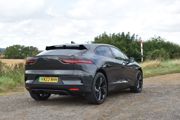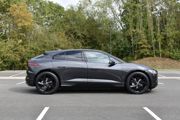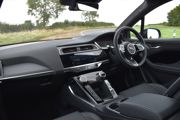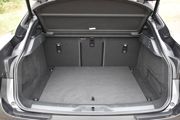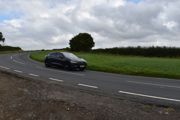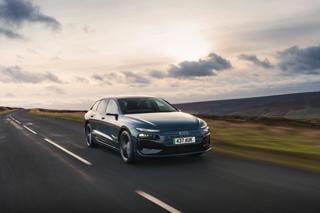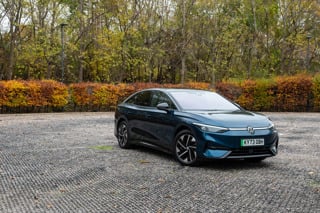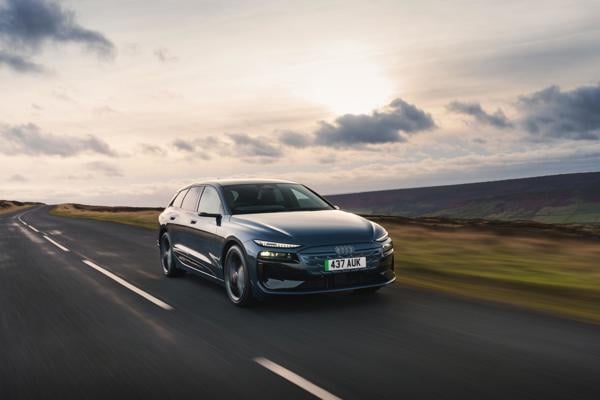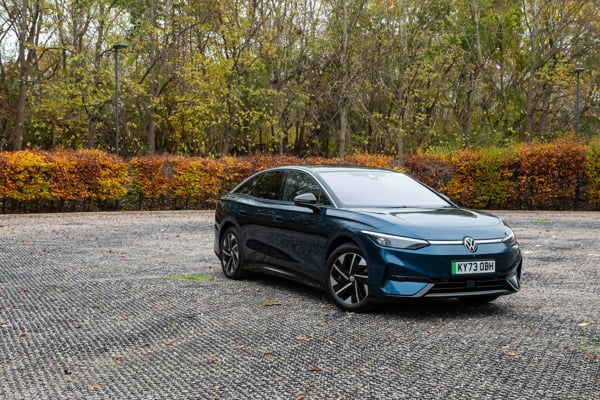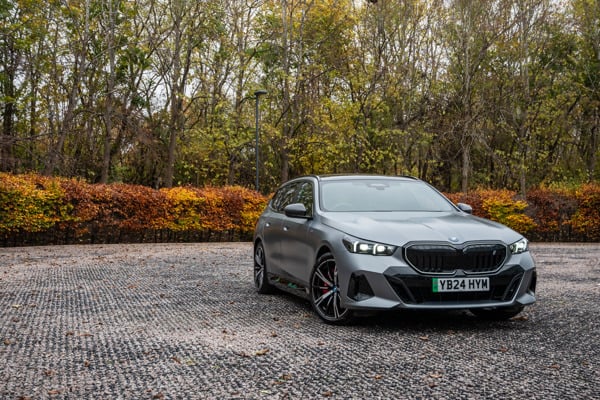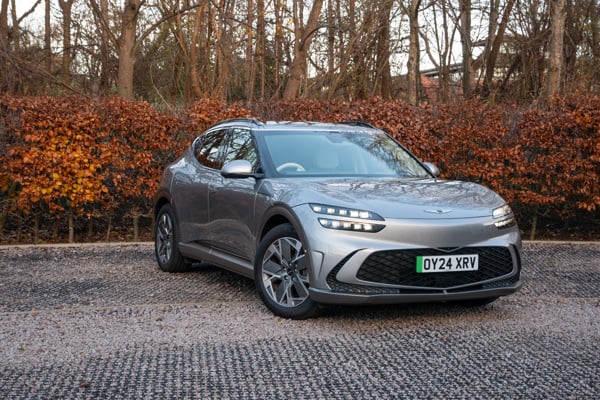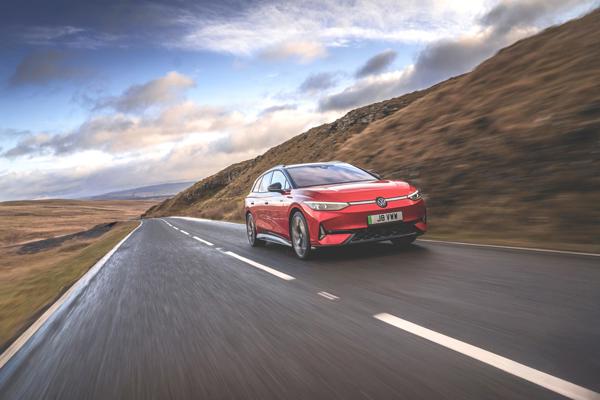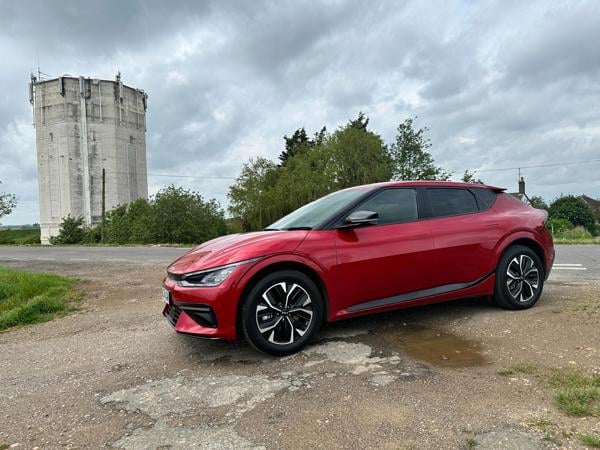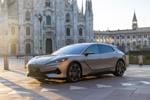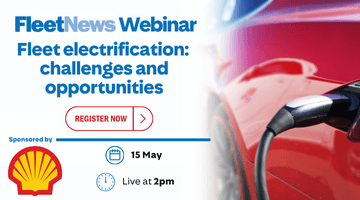Review
Press D for drive, push the accelerator and sheeesh! During a futile period of attempting to elevate the Jaguar I-Pace’s efficiency, I’d forgotten about its incredible acceleration.
Capable of a 4.8s 0-62mph sprint, the I-Pace will continue powering away to licence-losing speeds with no noticeable drop off. It simply goes and goes.
Oh course, as well as putting your driving licence at risk (as well as the safety of other road users), the one thing such heavy-handedness is guaranteed to do is destroy the efficiency: 2.0mi/kWh looms large in the rear view mirror, dropping the range to below 180 miles.
This is our farewell review and a reminder (again) that the I-Pace is an excellent premium car. Not just fast in a straight line, but quick around corners with a sharpness to its handling and a feeling of poise and agility. There’s a nimbleness that belies the Jag’s 2.2-tonne bodyweight.
It’s also comfortable as a long-distance tourer and comes with the practicality of a big boot and a second storage compartment under the bonnet.

In many ways, it offers a perfect combination of luxury, performance, comfort and versatility.
And yet… range falls well short of rivals, both WLTP and real-world, and charging speeds are an issue due to its ageing technology.
One area where the I-Pace doesn't fall short is its connected technology. The Jaguar Remote App has been a worthy addition to the ownership experience.
Stung by recent media criticism about the ease with which JLR products can be stolen, the company has taken significant strides to improve protection levels. This includes Secure Tracker, offered as a standard 12-month subscription (or £340 to extend to 36 months), which continuously monitors the vehicle.
If unauthorised movement is suspected, it will alert the driver via the app with a follow up call from the Stolen Vehicle Monitoring Centre.
The app also enables you to check if the car is locked and remotely lock it. Additional functions include pre-heating the vehicle during the winter, location via a beep and flashing lights, and the ability to look at individual journey profiles, which offered useful insight.
Sometimes it’s good to soften the obsession with efficiency. For a few weeks, we simply enjoyed the I-Pace’s biggest strength, namely its outstanding performance.
Game-changer now showing its age
We’ve grumbled a few times about the Jaguar I-Pace’s ageing battery technology – its large, inefficient 90kWh battery is currently returning 2.4mi/kWh, or range of 216 miles versus WLTP of 255 miles. It also takes an age to charge supporting only up to 100kW rapid charging and 11kW AC charging.
But it’s worth remembering that at launch in 2018, it was a game changing moment for the brand, giving SUV buyers access to a viable electric option. It offered space equivalent to a class above, it had outstanding handling, it had incredible performance and it offered decent range. All for the price of a well-specced F-Pace.
It was also the first car to credibly challenge Tesla’s electric dominance, leaving its German rivals (temporarily) in its wake. And it sold well.

And today? It is still one of the best looking EVs on the market, constantly drawing admiring glances from onlookers. It remains a joy to drive, with exceptional acceleration, excellent handling and outstanding grip. OK, the mushy brake pedal takes a bit of getting used to, but everything else is pin sharp while not compromising on comfort.
The I-Pace is, as we’ve previously mentioned, a superb premium car. The only drawback is its rivals have accelerated away with their battery technology. They have longer range and faster charging.
An additional gripe: they also tend to have longer cables, enabling front or reserve parking charging. The Jaguar’s charging port is on the front nearside panel and the cable is not long enough to reach a charger positioned on the rear offside when the car is reserve parked; you have to go in frontways, which some risk-focused companies forbid.
Would I have one? In truth, I’m finding it increasingly easy to live with, despite the range limitations. Although, even here, reducing my top speed to 60mph makes a massive difference on efficiency compared to 70mph on motorways, as does dipping to 50-55mph on 60mph roads. Much less air resistance means much greater range – often 20-30 miles over a full tank.
How does it compare to rivals?
With potential fleet buyers having a little over a year to continue offering the I-Pace on their choice lists before Jaguar discontinues the model, closing the chapter on a seven-year lifecycle, is it still worth considering the model?
Our latest review is about the hard-headed stuff: the financials. We’ll compare the I-Pace against three of its closest competitors for running costs – the Audi Q8 e-tron, BMW iX and Mercedes-Benz EQC.
Our range-topping I-Pace Sport comes in at £79,940 (before options). The Q8 S Line is £79,090, iX xDrive 40 Sport £79,855 and EQC AMG Premium £81,180.
The Audi comfortably beats the other models when it comes to depreciation, costing 66p per mile (ppm) or losing £52,790 over four years/80,000 miles. Interestingly, the BMW only just shades the Jaguar (70.23ppm to 70.37ppm – both losing a touch over £56,000) with the Mercedes trailing in the taillights at 77.94ppm, losing £62,295 – almost £10,000 more than the Audi.
The order changes on service, maintenance and repair (SMR) costs, with the iX costing least, at 5.47ppm, followed by the EQC (6.29ppm), Q8 (6.45ppm) and I Pace (7.15ppm).
The BMW makes further gains when it comes to fuel costs, thanks to better efficiency. At 20.92ppm (on 3mi/kWh), there is a noticeable gap to the Jag (23.01ppm on 2.78mi/kWh), Audi (23.12ppm on 2.7mi/kWh) and Mercedes (24.06ppm).
Based on those three metrics, the Audi Q8, thanks to its superior residual value, just edges out the BMW iX as the best value premium electric SUV in this competitor set with a running cost of 95.63ppm. Over four years/80,000 miles, it will cost £76,504.
The iX will cost £77,296 (96.62ppm), with the Jaguar I-Pace claiming third place at £80,484 (100.53ppm), leaving the Mercedes-Benz EQC to prop up the table at £86,642 (108.28ppm).
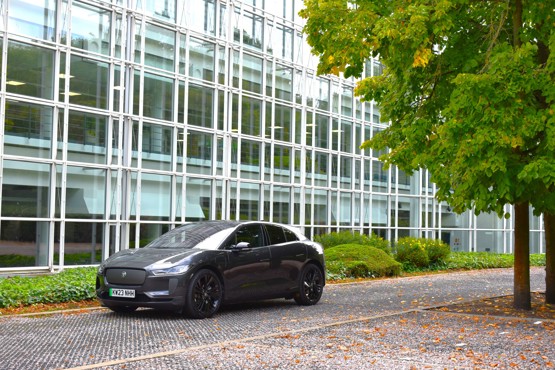
The figures are one thing, but drivers will be looking at a range of criteria when considering which car to select, including looks, performance, comfort, safety and technical features – scroll down for our thoughts on how the I-Pace measures up here.
With this in mind, when looking at the 2023 sales charts, who wins the popularity contest?
Perhaps surprisingly, it’s the most expensive car on paper, the Mercedes-Benz EQC. Last year, it sold 7,280 units, with 5,386 of those going to true fleet.
The Audi Q8 e-tron is runner up, on 4,787 units (3,819 true fleet), with the BMW iX close behind on 4,587 (3,369 true fleet).
While the I-Pace comes last, on 3,165 (1,580 true fleet), it has been around by far the longest - since 2018, whereas the others were launched within the past three years.
To be so close to these relative newcomers, on ageing battery technology, is testament to the enduring appeal of the I-Pace in the company car market. It will be missed when production ends in 2025.
Interior comfort
After spending a few days testing some other cars, returning to the Jaguar I-Pace gave me a fresh evaluation: the steering is extremely heavy.
I hadn’t noticed previously but compared to the light touch of the MG 4 or the well weighted offering from the Renault Austral, the I-Pace steering wheel requires a great deal of wrestling at low speeds. It makes manoeuvring around tight car parks quite challenging, although the firmness does help when travelling at higher speed on the motorway.
During our first couple of months with the I-Pace, during the warmer weather, we were averaging 2.7mi/kWh, giving a theoretical range of 246 miles (which compares favourably to the official WLTP combined figure of 255 miles). Winter is now here, and the efficiency has quickly dropped to just 2.5mi/kWh for a range of 225 miles – although the full charge is showing just 219 miles.
The reduction is purely down to the effects of the cold weather on the battery efficiency; it isn’t due to using the aircon, seat warmers or other range-sapping equipment.
Thankfully, even with the aircon turned off, the heater is quite effective at warming up the interior. The next option will be to use the heated seats, which drains less charge than aircon.
Whether warm or cold, the interior of the I-Pace is an enjoyable space for front and rear occupants. It offers plenty of head, leg and arm room with lots of cubby holes and compartments to store or hold kit and drinks. Front seats are comfortable with good side and lumbar support and excellent head rests.
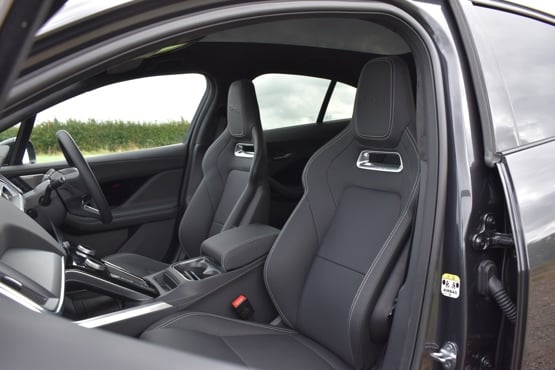
The phone charging bay is a simple ribbed horizontal surface which prevents mobile devices from sliding about and the sat nav is easy to use, aided by voice recognition which is pretty accurate – as long as you speak clearly. Multiple viewing options are available including 3D, although I invariably switch to Apple CarPlay’s Google Maps.
Less effective are the gear selector buttons for drive, neutral and reverse: they need pushing firmly to engage and a visual check is recommended before attempting a manoeuvre. I personally prefer the reassurance offered by a stick switch or rotary wheel.
Like many premium marques, Jaguar has opted to integrate most of the commands into the infotainment system with a touchscreen that is tricky to use while on the move. Thankfully, many of the functions are assisted by steering wheel controls.
A second touchscreen sitting below the infotainment screen comprises the aircon but also has rotary wheels to change the temperature, fan speed and heated seats which makes it much more practical.
Kudos to Jaguar for offering a physical option rather than relying only on touchscreen controls.
Range and efficiency
As a car, the I-Pace is an impressive premium product. It offers an excellent driving experience, potent performance, is well equipped, has a high quality interior and is undoubtedly striking to look at, prowling the roads in a manner befitting a big cat.
As an electric car, though, it’s underwhelming. There are positives: acceleration is progressive across the range - unlike some rivals which are front loaded for an explosive launch – which results in excellent mid-range bursts of speed. The 0-62mph launch is a spritely 4.8 seconds.
However, the range and efficiency are disappointing.
The I-Pace houses a sizeable 90kWh battery but offers range of around 240-250 miles (official WLTP is 255 miles). Consequently, efficiency falls noticeably below the expected lower threshold of 3mi/kWh.
The benchmark has been set by our two most recent BEV experiences: the Volkswagen ID4 (82kWh battery) averaged 3.6mi/kWh, while the Hyundai Ioniq 5 (72.6kWh) was an impressive 4mi/kWh.
The three cars are broadly similar in size with the I-Pace slightly longer but lower in height than the other two cars. There is a weight difference though, with the I-Pace the heavyweight at 2,226kg unladen, around 100kg more than the ID4 and more than 300kg heavier than the 1,905kg Ioniq.
That will also affect the efficiency, although the I-Pace’s lower roof height does make it more aerodynamic than the other two models.
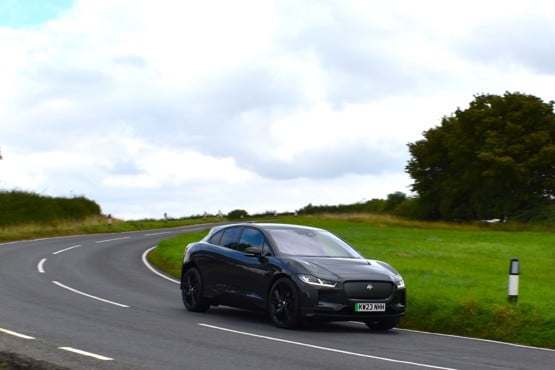
Over the course of our first two months, during the warmer weather, the I-Pace is averaging 2.7mi/kWh. Efficiency from cold is particularly poor; drive away after disconnecting from the charger and the performance is much better.
Although mi/kWh has become the accepted measurement for BEV efficiency, the I-Pace computer offers an alternative view - or, more precisely, views.
The default setting is kWh/100 miles. For the record, we’re on 36.5kWh/100 miles. This can be changed by scrolling through the menu to the even less helpful kW/mile. Both options are also available as kilometre readings.
We’re tried various things to improve the efficiency reading. There are two options for battery regeneration – low or high - which helped a little.
There is also eco mode, while generally adds 5-6 miles to the range when selected by adapting the powertrain response and cuts the amount of energy the climate control system uses. Slightly annoyingly, eco mode has to be chosen each time you start the car; it reconfigures to normal mode when you switch off the ignition.
The other negative is the size of the battery: 90kWh takes a lot longer to charge than the 70/80kWh options of rival models.
Officially, it takes 12.75 hours on a 7kW home charger (0-100%). On a rapid charger, the I-Pace charges at 220 miles per hour. However, the ID4 charges at 400 miles/hour and the Ioniq 5 at 560mi/hr.
Jaguar I-Pace Sport joins our fleet
The Jaguar I-Pace still looks as stunning and fresh as the day it was launched (five years ago).
Competing against the likes of the newer BMW iX3, Polestar 2 and Mercedes-Benz EQC, the I-Pace continues to hold its own in the premium stakes with plush materials throughout, including soft leathers and suede cloth headlining, an impressive 10-inch infotainment touchscreen, flush-fit door handles which emerge when the car is unlocked and multi-function steering wheel.
The downside? It comes at a cost. Our test car is a frankly eye-watering £83,720 (£79,940 base price with £3,725 of options).
Yes, it’s the top trim (of four options – S, SE, HSE and Sport). However, two of those comparable models are priced £64,110 (iX3), £52,895 (Polestar 2), although the EQC is a spikier £78,920.
Jaguar, itself, appears to have raised the white flag with the recent announcement that it will stop selling the I-Pace in 2025, despite decent success (it sold just under 4,800 last year).
So, with just over two years’ worth of registration time left, it is worth fleets and their driver considering this car?
That’s the key question we’ll be answering over the next six months as we consider driver enjoyment, competitive running costs, efficiency levels, internal living space and other criteria to deliver our verdict sometime in January 2024.
Follow us on that journey which begins with an overview of the main facts.
The I-Pace comes with a 90kWh battery which states a WLTP combined efficiency figure of 255 miles.
Charging time on a 7kW AC home charger from 0-10% is 12.75 hours with a five-metre charging cable. That drops to 44 minutes for a 10-80% fill on a 125kW DC rapid charger.
Max power output is 400PS with torque at 695Nm, resulting in a top speed of 124mph and a 0-62mph sprint of 4.8 seconds. Interestingly, the engine management set up means you don’t get the usual aggressive electric surge from standstill; rather the acceleration (while still admittedly rapid) is more linear across the range.

Our car sits on whopping 22-inch gloss black alloys with self-seal tyres which, matched to the Carpathian Grey (almost black) finish, gives the car real attitude on the road.
We’ve mentioned the price tag and some of the kit, but also included is an array of safety tech (lane keep assist, blind spot assist, rear traffic/collision monitor, traffic sign recognition, camera, parking aids, steering assist and emergency braking), plus powered tailgate, all surface progress control, heated seats/steering wheel and voice control.
Optional extras on our car include: four-zone climate control (£630), lockable cooled glovebox (£100), Wi-Fi Enabled with one-year data plan (£440) and 36-month Secure Tracker (£340 – a two-year extension to the standard one-year cover).
Specs
| Manufacturer | Jaguar |
| Model | I-Pace Estate |
| Specification | Jaguar I-Pace Estate 294kW EV400 Sport 90kWh 5dr Auto |
| Model Year | 2023.00 |
| Annual VED (Road tax) | £10 |
| BIK List Price | £79,940 |
| Range | 261.00mile(s) |
| CO2 | N/A |
| BIK Percentage | 2% |
| Insurance Group | N/A |
| CC | 1 |
| Fuel Type | Electric |
| Vehicle Type | Large car |
| Luggage capacity (Seats up) | 505litres |
| Doors | 5 |
Running Costs
| P11D | £79,940 |
| Cost per mile | 105.04ppm |
| Residual value | £22,375 |
| Insurance group | N/A |
| Fuel Type | Electric |
| Cost per mile | 471.02ppm |
| Fuel | 3.18ppm |
| Depreciation | 464.45ppm |
| Service maintenance and repair | 3.39ppm |
Rivals
Info at a glance
-
P11D Price
£79,940
-
MPG
N/A (WLTP) -
CO2 Emissions
N/A -
BIK %
2% -
Running cost
3 Year 60k : £22,375 4 Year 80k : £18,225 -
Fuel Type
Electric -
Range
261.00mile(s)



